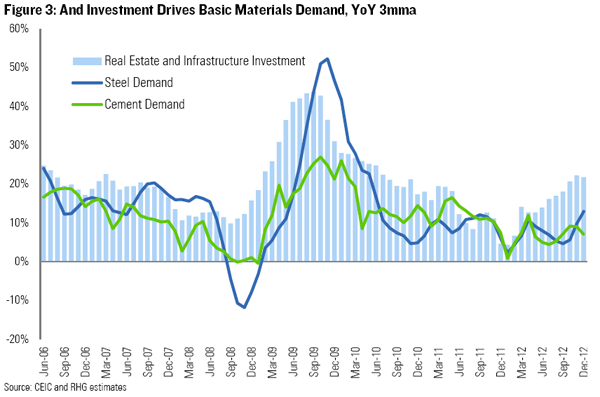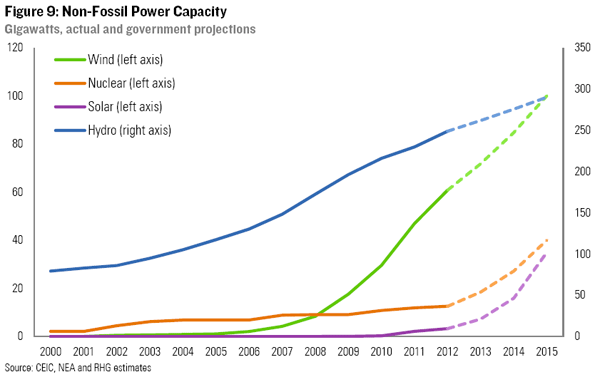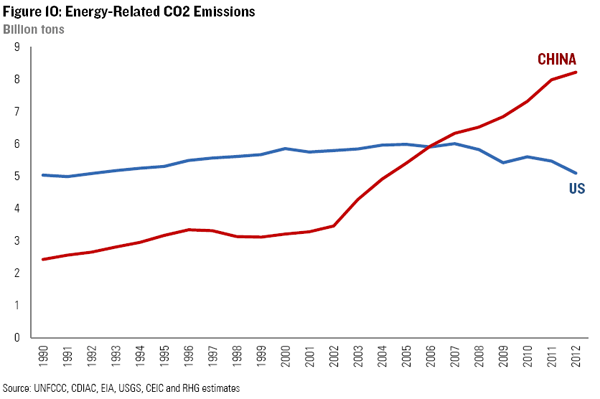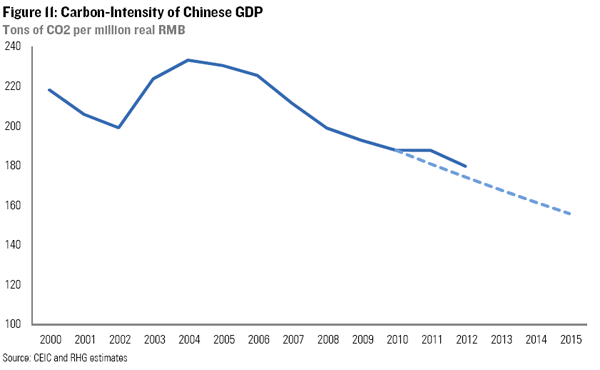China’s 2012 Energy Report Card
China’s 12th Five Year Plan includes a bevy of energy targets Beijing hopes to achieve between 2011 and 2015.
China’s 12th Five Year Plan includes a bevy of energy targets Beijing hopes to achieve between 2011 and 2015. Late last week the country’s National Bureau of Statistics released full-year energy supply and demand data for 2012, providing an early indicator on how China is doing two years into the plan. We’ve combed through the numbers, done the math, and offer a report card on Beijing’s progress to date in achieving its big three energy ambitions.
Target 1: Reduce the Energy-Intensity of the Economy by 16%: A slow-down in overall economic growth and, more importantly, a slow-down in energy-intensive industrial production, took its toll on energy demand in China in 2012. Coal and power consumption grew by only 2.5% and 5.5% respectively, down from 9.7% and 11.9% in 2011. That dragged overall energy demand growth down to 3.9% – the lowest level China’s seen in more than a decade. While bad news for bulk commodity markets, it’s good news for Chinese energy policymakers. Energy-intensity fell twice as fast in 2012 as in 2011, putting the country back on track to meet the 2015 target.
Target 2: Increase Non-Fossil Energy to 11.4% of Total Supply [UPDATED]: Though overall power demand growth fell in 2012, the share of Chinese electricity generated from renewables increased from 15.7% to 19.4% thanks to a recovery in hydro and increased wind generation. Renewable and nuclear power combined accounted for 94% of all electricity generation growth in China in 2012. And preliminary estimates suggest the share of total energy supply from non-fossil sources increase from 8% to 8.5-9%. That’s a significant improvement over 2011 when nuclear and renewables’ share of energy consumption fell, but the gains of 2012 will be hard to repeat this year.
Target 3: Cut the Carbon-Intensity of GDP by 17%: Slower energy demand growth combined with increased non-fossil energy supply curbed Chinese emissions growth in 2012. We estimate CO2 emissions rose by 3.2%, down from 9.3% year-on-year growth in 2011. That means the carbon-intensity of the Chinese economy declined by 4.3% – a welcome improvement over 2011 when it remained unchanged. But the carbon-intensity of Chinese GDP will need to fall even faster – by 4.6% a year between now and 2015 – to meet Beijing’s 12th Five Year Plan commitment.
Target 1: Energy-Intensity
Late last week China’s National Bureau of Statistics (NBS) announced that overall energy demand in China increased by only 3.9% in 2012, the slowest rate in more than a decade (Figure 1). Same for electricity demand, which was up by only 5.5% last year after growing by more than 12% on average between 2001 and 2011. This was thanks in part to weaker economic growth. Chinese GDP expanded by 7.8% in 2012 compared to 9.3% in 2011 and a 2001-2011 average of 10.4%. Equally important, however, was a change in the structure of economic growth that reduced the energy-intensity of Chinese GDP (which we first flagged in our July 2012 China Point of View).
Unlike in developed countries where consumer activity (heating homes, lighting shopping malls and fueling passenger vehicles) accounts for the majority of overall energy demand, in China industry is the largest consumer of energy overall and accounts for three quarters of total demand for electricity. In fact, production of basic materials like cement, steel and non-ferrous metals alone accounts for nearly half of the country’s annual energy bill. The chemicals industry consumes more energy than all Chinese passenger vehicles and the steel industry uses more energy than all the homes in the country combined (for a vintage overview of China’s energy landscape, see our 2007 China Energy: A Guide for the Perplexed, which one of these days we’ll get around to updating).
So power demand, as well as energy demand overall, tracks basic materials production relatively closely, as shown in Figure 2. And basic materials production is driven in turn by real estate and infrastructure investment and construction activity as shown in Figure 3.



In 2012, government restrictions on real estate investment and tightening liquidity cut construction growth in the sector in half. At the same time, most of the infrastructure projects green-lit during the 2009 stimulus had worked through, leaving little year-on-year growth in infrastructure-related basic materials demand. When headline economic growth fell faster than policymakers were comfortable with as the year progressed, Beijing announced a mini-stimulus, which provided a modest boost to infrastructure investment during the second half of the year. And property construction picked up a bit during the last few months of 2012 as well. But this wasn’t enough to keep basic materials demand growth from decelerating sharply on a full-year basis. Steel demand growth fell from 6.7% in 2011 to 3.5% in 2012. And cement demand growth fell from 12% to 5.2%.
This slowdown in basic materials demand dealt a blow to steel company profit margins and global bulk commodity markets. Yet despite some anxiety over the pace of the adjustment, it was exactly the kind of economic shift Beijing had been trying to engineer. Chinese policymakers recognize that keeping economic growth above 7% will require “rebalancing” the economy away from investment towards consumption and away from industry towards services (see Dan Rosen’s recent China Point of Views or his assessment of Beijing’s medium-term economic outlook here). Policies to restrain construction activity, and the heavy industrial production that goes along with it, are part of the rebalancing policy prescription.
And they deliver with energy savings benefits as well. Industrial power demand (closely tied to investment) grew by 4.2% in 2012, down sharply from 11.9% in 2011 (Figure 4). Meanwhile service sector and residential power demand growth came in pretty close to 2011 levels as private consumption has held up relatively well. Since industry accounts for three quarters of overall electricity consumption, as mentioned above, headline power demand growth fell to 5.5%, mirroring the slowdown in industrial power demand.

Slower power demand growth means slower coal demand growth as coal fuels just under 80% of Chinese electricity generation. But nearly half of coal demand in China comes from industry directly – and that got hit by weak construction activity as well. Coal demand growth fell to 2.5% last year from 9.7% in 2011 (Figure 5). Oil and natural gas demand, held up better. Both have more consumption-led demand exposure than coal that hedges their investment-led demand risk, and as a result both continued to grow at close to 2011 levels last year. But since oil and natural gas account for less than 25% of Chinese energy supply combined, overall energy demand fell sharply on the back of coal and power.

With Chinese energy demand growing half as fast as the economy as a whole in 2012, the energy-intensity of GDP declined by 3.6%. That’s greater than the 3.4% annual improvement Beijing needs to achieve its desired 16% reduction in energy-intensity between 2010 and 2015. But it’s not quite enough to offset the meager 1.9% reduction in 2011 (Figure 6). Energy-intensity will need to decline by 3.9% each year for the next three to deliver a 16% cumulative reduction by the end of the 12th Five Year Plan.
China won’t be able to achieve that kind of energy-intensity improvement through technical efficiency gains alone. Beijing will need to continue to change the structure of the economy, which requires fundamental reform to the financial sector, educational system and social safety net (among others) — no small task. This will be a critical year for the new Chinese leadership in deciding whether to take the steps necessary to make rebalancing stick, as Dan discussed in his January China Point of View.

Target 2: Non-Fossil Energy
Beijing’s second major energy objective in the 12th Five Year Plan is to increase the share of energy supply coming from non-fossil sources (nuclear and renewables) to 11.4% in 2015, up from 8.6% in 2010. Like the energy-intensity target, the non-fossil energy target is legally binding, and is a half-way point to China’s international pledge to increase non-fossil energy to 15% of total energy supply by 2020. Beijing made little progress towards achieving this goal 2011. In fact, non-fossil energy’s share declined to 8.0% due to a reduction in hydropower generation. Last year proved to be much better.
Chinese companies added 83 gigawatts (GW) of new power generating capacity in 2012. Of this, 61% (51 GW) was thermal power – largely coal (Figure 7). This was a slight decline from 2011’s thermal power additions, but still twice as much coal-fired power built in one year as currently exists in the state of Texas, and more than all coal-fired power installed in the Northeast US. But 35 GW of non-fossil capacity was added as well in 2012. Two new nuclear reactors came online, adding just under a gigawatt of new capacity on an annualized basis, but the rest was renewables, primarily wind and hydro.
While big in absolute terms, 35 GW of non-fossil capacity is about what China added in 2011. The big change relative to 2011 occurred on the generation side. Thermal power generation, which grew by 483 billion kwh in 2011, was roughly flat in 2012 (Figure 8). Meanwhile, hydropower recovered from its 2011 slump, coming in 26% above 2010 levels. And wind power generation continued to grow as more turbines got connected to grid. All told, nuclear and renewables accounted for 94% of the growth in Chinese power generation last year.

Converting these power generation numbers into tons of standard coal equivalent (SCE), the measure the NBS uses to assess non-fossil energy’s share of total supply, is a challenge. The conversion factors used by NBS change from year to year and the agency provides little information on their methodology. While NBS has published a total energy demand number in SCE for 2012, the coal, natural gas and crude oil numbers are still only available in physical units (metric tons, billion cubic meters, etc). Full year petroleum demand data including product trade is not yet available. Nuclear and renewable numbers are only available in kilowatt hours and NBS doesn’t publish solar power generation. Using conversion factors from 2011 and petroleum demand figures from the IEA, we estimate that non-fossil’s share of total energy supply increased to 8.5%-9% in 2012 from 8% in 2011. What NBS ultimately publishes later this year could certainly be outside that range given the methodological uncertainties, but based on preliminary data it appears the non-fossil share is now trending in the right direction. [UPDATE: An earlier version of this analysis overestimated the share of non-fossil energy in 2012. Many thanks to the LBL China Energy Group for helping to correct our calculation.]

Continuing to expand non-fossil energy at the current rate will be a challenge. The big gains from hydro in 2012 weren’t from new capacity so much as a rebound in generation that can’t be repeated. And the capacity growth rate for hydro projected by China’s National Energy Administration slows in the years ahead (Figure 10). The Chinese government is hoping to double wind power capacity between now and 2015, but developers continue to face challenges selling to the grid.
The really steep projected growth is in nuclear and solar capacity. The 12th Five Year Plan calls for 40 GW of installed nuclear capacity by 2015. China has 13 GW today, and more than 25 GW under construction, so the target is achievable provided there aren’t significant delays in the projects already underway – a big if. And Beijing recently raised its solar capacity target from 21 GW to 35 GW, partially in response to a particularly nasty bout of air pollution in Beijing and other cities. This target is also achievable given excess PV production capacity available in the market. But policymakers will need to get the incentives right.

Target 3: Carbon-Intensity
The third legally binding energy target in the 12th Five Year Plan is a 17% reduction in the carbon-intensity of Chinese GDP between 2010 and 2015. The NBS doesn’t publish annual CO2 numbers and the Chinese Government’s most recent official CO2 emissions inventory is for 2005. Using that inventory as a reference point, and annual CO2 emissions factors from CDIAC, we estimate the CO2 emissions corresponding to the annual coal, oil and natural gas demand numbers published by the NBS. We also include non-energy CO2 emissions from cement, steel, lime, limestone and calcium carbide production using output data from NBS and USGS and the CO2 emission factors implied in China’s 2005 emissions inventory. We do not include land-use change or forestry.
Using this approach we estimate that total Chinese CO2 emissions grew by 3.2% in 2012, with energy-related CO2 emissions growing by 2.9%. We don’t have official 2012 US emissions numbers yet but we estimate that energy-related CO2 emissions fell 3.8% last year in the US (Figure 10).

While Chinese CO2 emissions grew in 2012, they grew at a much slower than the 9.3% year-on-year increase we estimate occurred during 2011. And that means China is making progress towards achieving its carbon-intensity goal following a year in which the carbon-intensity of the economy remained unchanged (Figure 11). But to achieve a 17% reduction relative to 2010 levels by 2015, the carbon-intensity of the Chinese economy will need to fall by 4.6% a year each year for the next three, a bit faster than the 4.3% reduction achieved last year. That makes meeting the energy-intensity and non-fossil energy targets a must.
